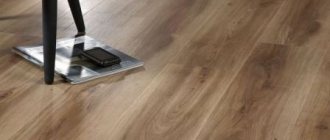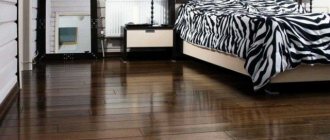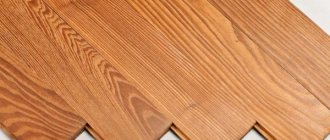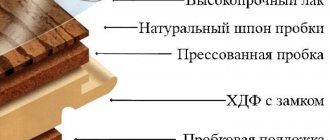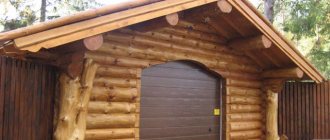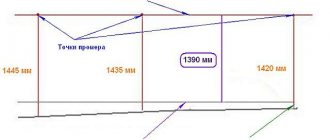The difficulty in choosing a decorative floor covering lies in the variety of materials and their installation technology. Along with traditional parquet and linoleum, vinyl laminate has recently appeared on the market. Externally, it imitates the structure of wood, and installation is in many ways similar to soft coverings. Therefore, before purchasing, you should analyze the advantages and disadvantages of vinyl laminate, reviews from professionals. Based on the data obtained, the feasibility of purchasing this coverage is determined.
Decide on the operating class
The key parameter that directly affects the service life of the laminate is the service or wear resistance class. Depending on the nature of the premises, flooring is divided into four types:
- Class 31 - low traffic and light loads (storeroom, bedroom, meeting rooms, offices). The service life in domestic conditions is about 12 years, in commercial conditions - 2-3 years.
- Class 32 - average traffic and loads (corridors, living rooms, kitchens, offices). The service life in domestic conditions is about 15 years, in commercial conditions - 3–5 years.
- Class 33 - intensive traffic and loads (shops, cafes, hospitals). The service life in domestic conditions is about 20 years, in commercial conditions - 5–6 years.
- Class 34 - the most intense traffic and loads (stations, supermarkets, cinemas). The service life in domestic conditions is about 30 years, in commercial conditions - 7–15 years.
The higher the class, the longer the coating will last. If you don’t want to overpay, take a laminate one class higher than required - this will be quite enough. The best option for a house or apartment is class 32. This flooring is suitable for any room and has the necessary margin of safety.
If you plan to lay a more wear-resistant laminate only in the hallway and kitchen, and in the other rooms get by with a cheaper option, then keep in mind that products from different manufacturers do not always combine well. Choose laminate of the same brand and be sure to have the same thickness.
§ 1. Causes of mold
Favorable conditions for mold development are high humidity and temperatures from +5 to +15 degrees. We list the main reasons why mold appears under laminate flooring:
Causes of mold
- Moisture. There are plenty of sources of moisture: accidentally spilled water on the floor, periodically flooded neighbors, frequent drying of laundry, and so on. But most often these are water leaks in taps, water supply and sewer pipe connections.
- Lack of ventilation in the room, no ventilation.
- Insufficient drying before laying the laminate.
Select thickness
bestlaminate.com
Laminate with a thickness of 4 to 14 mm is available for sale. But unlike the class, the rule “the more the better” works here with some reservations.
A thick laminate is definitely stronger than a thin one, has less load on the locking joints and is less noisy when walking on it. Due to slight deflection, it allows you to hide differences in the base, while a thin coating will copy all the irregularities. At the same time, thin laminate warms up much faster, so it is preferable when installing heated floors.
The optimal thickness is 8 mm. With proper preparation of the base, such a laminate is in no way inferior to thicker and more expensive ones. In addition, it is suitable for arranging heated floors.
Unnatural appearance
Laminate, of course, differs for the better from linoleum. Thanks to its excellent imitation of stone, wood or other material, laminate looks very solid and attractive. However, the key word in this case is “imitation”. Upon closer inspection of the coating or with the first step taken on it, the fake becomes obvious, and the illusion disappears like smoke. Fans of solidity and natural materials are unlikely to like this nuance.
Opinions from the forums:
“At first it was unusual - they walked on the laminate floor as if they were walking on plastic. Parquet or even floorboards are much more beautiful and natural.”
“The laminate feels artificial. Barefoot you feel the unnaturalness of the coating, it does not “breathe”.
Consider the dimensions of the board
Laminate flooring is available on the market in widths from 90 to 400 mm and lengths from 300 to 1,845 mm. Both parameters affect the installation process and the final appearance of the floor covering.
Narrow laminate is used to imitate parquet and boards, wide laminate is used for ceramic tiles. Long panels provide a more monolithic coating, but are more difficult to install. Short ones look better due to their similarity to an array, but they have more joints.
Focus on the appearance and design requirements, but also consider the dimensions of the room. Long laminate flooring in a small room is inconvenient to work with, not to mention the amount of cuttings.
Vinyl laminate base
Although vinyl laminate does not impose strict requirements on the base, you still have to fulfill the required minimum. The base must be cleaned of dirt, dried and must not have potholes or protrusions.
For ideal and high-quality laying of a soft laminate, it is better to produce a base that meets all the requirements of a conventional laminated coating. Such preparation will allow you to forget about problems with the floor for many years.
The algorithm for preparing the base is as follows:
- Concrete. It is necessary to remove the old coating, remove dirt, dust and debris. Perform a visual inspection and if the surface is severely deformed, then it is necessary to install a rough screed. If the base is not badly damaged, but requires leveling, then leveling mixtures can be used.
- Tree. Existing beams and wooden planks are inspected, damaged parts are removed and new ones are installed and treated with mortars with strict adherence to the general floor level. It is advisable to install plywood boards on top of the old floors. Also, all screws are sunk into the wood.
- Old coatings. If tiles or laminate are laid, then you can not remove it and lay the flexible laminate directly on it.
If vinyl laminate with smart film is installed, then the requirements for the base increase somewhat due to the fact that such panels fit tightly to the base. If there are significant holes and depressions, the appearance may be spoiled.
The best solution for such a connection would be to level the surface with self-leveling mixtures.
Think about moisture protection
In terms of moisture-proof properties, laminate, of course, cannot compete with tiles. Conventional panels are strictly incompatible with water. But if you choose a special coating, you can easily install it in the hallway, on the balcony and even in the bathroom. Based on the type of protection against liquids, a distinction is made between moisture-resistant and water-resistant laminate.
The first differs from conventional panels in having high-density base slabs, moisture-proof treatment of interlocking joints, and antibacterial impregnation. This coating is not afraid of dampness, frequent contact with moisture and is suitable for the kitchen, corridor, hallway.
Cutting waterproof laminate / strport.ru
At the base of the waterproof laminate is a durable PVC board with air chambers that improve sound and heat insulation. In addition to the wear-resistant top layer, it has a water-repellent and anti-slip coating. This laminate can withstand direct contact with water and is well suited for the bathroom.
The weak point of laminate is the joints. It is in them that moisture gets in; with prolonged contact, it causes the slabs to swell. If there is little water and it is quickly removed, most likely even ordinary laminate will not be damaged. If desired, you can treat the lamella locks with a special paste or sealant, and then any laminate will have moisture-proof properties.
What is soft laminate
Soft planks, realized in the form of panels, have acquired the name vinyl laminate. This product consists of the following layers:
- The top layer plays a protective function and is made of aluminum oxides and polyurethane. This layer is also responsible for the aesthetic component of the product. Allows you to imitate the following coatings: wooden panels, rocky surfaces, as well as all kinds of tile compositions. Polyurethane guarantees the safety of the product from shock loads. This layer belongs to wear resistance class 43.
- The bottom layer is made of vinyl and is also endowed with wear-resistant properties. An adhesive base or smart tape is placed on this layer, which allows the installation of panels without specialized locking devices.
Specify the type of locks
Modern laminate panels are held together using tongue-and-groove joints. They allow you to quickly install the floor and at the same time retain the ability to disassemble it if necessary. There are many varieties of such connections, but they can all be divided into Lock and Click.
remont5.ru
Lock locks are the most common and affordable. The laminate board has a tongue on one side and a groove on the other. When laying, the panels are driven into each other with a mallet through a wooden spacer. Over time, these connections wear out from friction and gaps appear. Disassembling and reassembling such locks is quite problematic.
remont5.ru
Click locks are an improved version without the disadvantages of the first. The tenon here has the shape of a hook and is fixed by inserting the panel at an angle and then pressing. These locks provide a stronger connection, a less noticeable joint and can be reassembled multiple times. The downside is the high price due to the complexity of production.
Acoustic discomfort
This is another drawback that linoleum and often wooden floors almost always lack. Laminate, even laid on a standard substrate, has a peculiar “drum effect” - it makes a booming sound when walking in hard shoes or heels. Also, when laid on an uneven or unprepared surface, laminate slabs can often make an annoying squeaking sound when walked on. Using cork material 2-4 mm thick as a base partially helps to avoid such problems. At least protect the residents of neighboring apartments from them. But the price also increases significantly.
Opinions from the forums:
“The neighbors living upstairs have laminate flooring. Their movements in soft slippers cause such a roar that they just turn out the lights. And if someone, God forbid, runs or drops something, they can hear it three floors below.”
“We have inexpensive laminate flooring in our office space. It’s simply impossible to walk on it, especially in heels – it feels like a herd of horses is galloping.”
Decide if chamfers are needed
On the left is a laminate with a chamfer, on the right - without / elefanto.ua
Most laminates are made with solid, even edges, and after installation the coating looks monolithic. Some manufacturers make chamfers on the panels - small beveled edges along the edges. They clearly demarcate the planks.
The chamfers are two-sided and four-sided. In the first case, only the side edges are processed and the laid lamellas look like a long board. In the second, decorative edges are made along the entire perimeter of the panels and on the floor they look like pieced parquet boards.
Laminate with V-bevel in section / srbu.ru
According to the shape of the profile, the chamfers are divided into semicircular U-shaped and wedge-shaped V-shaped. Since these bevels are created by extrusion, the strength of the coating and the protective layer on the chamfers are completely preserved. The depth of the grooves themselves is insignificant and amounts to 1–2 mm, so dust and dirt do not accumulate in them.
Laminate with bevels is visually richer and looks like solid wood. But this is an exclusively decorative element and will not provide any advantages in installation or operation. Due to the complexity of processing the edges, the chamfers on cheap laminates are not as durable as those from well-known brands. Therefore, if you are on a limited budget, it is better to consider traditional options without chamfers.
Disadvantages of vinyl flooring
In addition to an impressive list of advantages, flexible laminate has a number of disadvantages:
- This is a product made from artificial elements that imitate natural materials, so some people may experience an allergic reaction. This means that before installation you need to keep the material in a ventilated room.
- Cheap soft laminate changes its appearance over time by fading or darkening, therefore, when purchasing laminated panels, you should not buy the cheapest option.
Vinyl plank structure
Don't go wrong with the color
Contrasting combination of floor and door / asmaters.org
As a rule, laminate flooring is combined in color with interior doors. And since their choice on the market is much smaller, it is preferable to look for laminate when the door has already been installed or at least purchased.
Finding doors and laminate flooring that perfectly match the shade is almost impossible. Therefore, contrasting combinations are most often chosen: dark floors and light doors, or vice versa. Also remember that the baseboard should match the color of the door, since it is, in fact, a continuation of the platband. If you choose a baseboard that matches the laminate, the border between the wall and the floor will turn out to be inexpressive.
Manufacturers
Today there are a huge number of companies on the market that produce such coatings. The reason is that the material is actively promoted, which means the demand for the product increases. People are actively buying coatings from manufacturers from Belgium, Korea, Austria, and Germany.
There is no point in listing all the manufacturers by name, since you will still have to choose a laminate based on your conditions.
It is only worth mentioning that today it will not be difficult to find the desired type and color of coating from the many available solutions.
It’s easy to purchase laminate of the desired color and texture - the range is quite wide
Please note that due to the active growth and popularity of some brands, there is a large number of counterfeit products today. Be extremely careful when purchasing covers. Look carefully at the product you are purchasing and ask for all necessary certificates of authenticity. If the price turns out to be too low, then this is the first “red flag” that the material is a fake.
Interesting! If in doubt, it is better to refuse the purchase.
flexible laminate
Don't forget the backing
The laminate is laid on a special substrate, which you will also have to buy. It evens out differences in the base, evenly distributes the load and reduces noise when walking. Such linings are made from various materials. Each of them has its own advantages and disadvantages.
From left to right: polypropylene foam, extruded polystyrene foam, wood fiber, natural cork
- Foamed polypropylene is the most budget-friendly substrate. It levels out differences in the base well and is not afraid of moisture, but it sags and is not suitable for rooms with heavy loads. Sold in rolls.
- Extruded polystyrene foam is an affordable substrate. Withstands heavy loads, provides good thermal insulation and is not afraid of moisture. Sold in sheets.
- Wood fiber is an expensive substrate. Eco-friendly, breathable material with excellent sound insulation properties. Sold in sheets.
- Natural cork is a very expensive substrate. Perfectly absorbs steps, soundproofs the floor, and is resistant to mold. Sold in rolls.
All substrates are available in several thickness options. The optimal indicator is 2–5 mm. A thicker lining only makes sense when additional heat and sound insulation is needed.
Installation technology
NOTE!
Before you begin laying the material, you must turn off the heated floor, if any. Switching off is carried out 2 days before installation, and switching on after installation is recommended to be done no earlier than 5-6 days later. This time is necessary for strong adhesion of the adhesive layer and general alignment of the material in the canvas.
The procedure for laying the material is relatively simple. The slats are placed offset by approximately half the length, as is done when laying conventional types of laminate . To do this, you need to cut some of them to length. To do this, it is best to use a stationery knife and a square.
Laying starts from the far corner opposite the entrance. The lamellas cannot be laid tightly against the walls; a gap of 4-6 mm is required. Before gluing the lamella, the protective polyethylene film is removed from the adhesive layer, the material is carefully placed in place, leveled and pressed to the base.
For stronger contact with the subfloor, it is recommended to roll the surface of the laminate with a roller.
Adjacent lamellas are laid end to end as tightly as possible, without gaps or cracks, and rolled with a roller in a similar way. In this way, all the material is laid over the entire area of the room.
If you purchased the type of laminate, equipped with a protruding adhesive tape on one side, installation also begins from the far wall opposite the exit. The adhesive layer protrudes from the panel to a sufficient length to ensure strong adhesion of the lamellas to each other. the first row is laid along the wall, retreating from it by 4-6 mm.
The second row is placed offset, for which the first lamella in the row is cut to the required length. Laying is done carefully, the lamella is applied to the previous one at an angle, leveled and only then pressed to obtain a strong adhesion .
Incorrectly installed parts are immediately torn off and reinstalled with corrected position.
If the work is carried out in a cold room, which is often the case when using heated floors in winter, since they are turned off a couple of days before installation, the adhesive layer is heated with a construction hairdryer to obtain the working temperature of the seam.
The joints are rolled with a roller for greater adhesion strength.
“It’s okay, he’ll sit down”
“The next day after filling the floor with self-leveling, the master began laying the laminate,” the girl continues. — Laminate, as we were told in the store and paid attention to the drawing on the packaging, is snapped together in long strips, and then these strips are connected to each other. So, the master hit him with a hammer. In response to my remark, “but in the store they told us differently,” my newly made friend assured me that he knew how to do it, and in general, “look how beautifully I did it.” Okay, I don't understand.
In some places the boards broke and were sealed with glue, in some places they sank by 1-2 cm, but with the words “no problem, it will settle,” the work went on. When my husband started asking questions, Yuri said: “It’s always like this, but okay, let’s lift it up and lay another piece of cork backing.” We agreed on this.
Then Yuri started wallpapering. Having laid out the sheets on the floor, he generously and sparingly poured glue on them, spilling it all over the fresh laminate left and right. I glued it up, closed the windows, sealed up the passage to the room and left.”
Warnings
If the pest returns again and again, you should think about replacing the coating. When, after numerous cleanings, stains appear with renewed vigor, try opening the tiles, floors or wallpaper in a small area and check whether mold has damaged them at the root. If this happens, it would be advisable to replace the damaged area. Otherwise, the hidden problem will continue to cause both aesthetic damage to the interior and harm to your health, since spores remain in the air of this room.
Hello mold
“Then the matter was coming to an end. We paid and parted ways, wishing him a happy holiday in Egypt and congratulating him on his upcoming birthday (he managed to tell a lot about his life). And we ourselves were glad that we also had money left for our honeymoon.
The ordered furniture arrived, we assembled it and put it in its place, all we had to do was wait for the sofa. Without wasting any time, we laid blankets on the floor and spent time in our beautiful new room.
And then the troubles began: we began to notice that the laminate not only did not smooth out in those places where we were promised, but, on the contrary, the boards began to rise at the short transverse joints.
We decided to write to Yuri, to tear him away from his rest a little. And they were very surprised to learn that his wife and child were resting, but he remained here and with a broken facial bone from a fall (we, of course, believe Yura) could neither live, nor breathe, nor work, and all that.
Everything became clear to us - we were in for the money. Experts were invited to assess the situation, everyone said: “It’s all moisture. The laminate is swollen and needs to be removed and dried. If the locks are not broken, replace them; if they are broken, buy new ones.” And then the pieces of the puzzle fell into place: the self-leveling agent did not dry, liquid glue penetrated into the gaps, the windows were closed for a day after wallpapering... That's it, let's sort it out. I started removing the baseboard and was horrified. Mold! Further - worse. Everything is moldy: laminate flooring, cork flooring, concrete floor, walls.
A defect report was drawn up and a new foreman was hired. With the money saved for the honeymoon, we bought new laminate flooring, underlayment, and plinth (about 1,000 rubles).
The floor has been treated for mold more than once. I leveled it again, because, as it turned out, two pieces of substrate are the height of stupidity. It didn’t take one day to dry, but almost five. So we got a beautiful completed renovation and a headache in the face of a former friendly and sociable finisher.
All work to replace the laminate and correct the “jambs” was done with the consent of Yuri, correspondence with him was “screened” just in case. According to the law, he had to redo all this within two weeks, but since he was injured by the “asphalt attack,” he was not able to.
He promised to pay me for a new laminate and return the job as soon as he returns to work in a month. Then another month, and then another and another. From August we got into the situation, until December we tried not to disturb him and mind our own business. The honeymoon was forgotten. The promise “exactly at the end of December” was accepted as final. Naturally, it was final for us, not for him.”
Some tips for eliminating the consequences of flooding
When saving laminate flooring from moisture after flooding, use some tips and tricks to make repair work easier and improve results:
- In case of minor flooding, in order to avoid swelling and deformation of the laminate, dismantle the baseboards along all walls in the room for the entire period of drying the coating, thereby ensuring that the laminate can expand unhindered. If the floor covering was installed correctly, then there is a small technological gap (about 1 cm wide) between the outer panels and the walls to allow the laminate to change sizes with changes in climate conditions. If there is no such gap or it is smaller, it is necessary to cut them by 1 cm in places where the outer panels are located close to the wall.
- When dismantling a laminated floor after a flood, it is imperative to number the slats, for example, in chalk, so as not to disturb their location during subsequent installation.
- In rooms with high humidity, it is recommended to use moisture-resistant PVC laminate for laying.
- It is recommended to process interpanel joints using a regular wax pencil. This will protect the floors to some extent from small amounts of moisture. There are special wax-containing products available for treating laminated flooring.
- To clean laminate floors, do not use abrasive or aggressive substances, as they will damage the surface protective film.
- Heaters should not be used to speed up the drying process of the panels, so as not to harm them.


